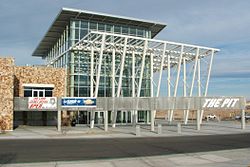The Pit (arena)
 |
|

The Pit as seen in 2011
|
|
| Former names | University Arena (1966–2009) |
|---|---|
| Location | Avenida Cesar Chavez & University Blvd SE, Albuquerque, New Mexico |
| Coordinates | 35°04′01″N 106°37′55″W / 35.067°N 106.632°WCoordinates: 35°04′01″N 106°37′55″W / 35.067°N 106.632°W |
| Owner | University of New Mexico |
| Operator | University of New Mexico, Associated Students of UNM |
| Capacity | Basketball: 14,831 (1966–1975) 18,018 (1975–2008) 14,586 (2009 renovations) 15,411 (2010–present) Concerts: up to 13,480 (2009–present) |
| Construction | |
| Broke ground | December 1965 |
| Opened | December 1, 1966 |
| Renovated | 2009 |
| Expanded | 1975 |
| Construction cost |
$1.4 million ($10.3 million in 2017 dollars) $60 million (renovations) |
| Architect | (original) Joe Boehning (2009 renovation) Molzen Corbin, Architect of Record Sink Combs Dethlefs, Arena Design Consultant |
| Tenants | |
|
New Mexico Lobos (NCAA) (1966–present) New Mexico Activities Association State Basketball Tournaments (1990–present) 1983 NCAA Men's Division I Basketball Championship |
|
The Pit, formally named WisePies Arena (aka The Pit), is an arena in Albuquerque, New Mexico serving primarily as the home venue of the University of New Mexico Lobo basketball teams. The facility opened in 1966 as University Arena, but soon gained the nickname "The Pit" due to its innovative subterranean design, with the playing floor 37 feet below street level. It would officially be renamed "The Pit" in 2009. The arena is located on the UNM South Campus and has a seating capacity of 15,411 for basketball and up to 13,480 for concerts, with forty luxury suites and 365 club seats.
The Pit has been widely recognized as one of the top college basketball venues in the nation, and as one of the loudest. The New Mexico Lobos have enjoyed tremendous success at The Pit, winning over eighty percent of their games there, while attendance for their games has consistently been among the best in college basketball. Renovations completed in 2010 added space to the facility, as well as state-of-the-art amenities for fans, coaches, and players.
The Pit has frequently hosted NCAA basketball tournament games, including the memorable 1983 Final Four.
Before construction of The Pit, Lobo basketball teams played at Johnson Gymnasium, a 7,800-seat multi-purpose gym on the University of New Mexico main campus. Lobo basketball was unsuccessful at the time that Johnson Gym opened, and it was rarely more than half-full for games. In 1962, UNM hired Bob King as head basketball coach, and he immediately transformed the Lobos into a winning program, reaching the finals of the National Invitation Tournament in his second season. Attendance at Lobo home games doubled, tickets were soon selling out, and plans for a larger arena began to take shape.
University administrators wanted a much larger facility while providing fans an unobstructed view from any seat. A suitably large building would normally require support columns, however, leading chief architect Joe Boehning to incorporate a roof designed by the Behlen company, a "stress skin system" made of light gauge metal supported by a series of trusses. The 338-by-300-foot (103 m × 91 m) roof was constructed first, just above street level, and the ground beneath was then excavated to form the bowl of the arena. The playing surface lies 37 feet (11 m) below grade, giving rise to the now-famous name. There are no supporting pillars in the seating area of the arena, so there are no obstructed views. Its compact area, steep grade, and the proximity of the seats to the floor contribute to its legendary noise level. The subterranean design won international recognition for Boehning. The arena originally had a seating capacity of 14,831 and cost a mere $1.4 million to build, about a fifth the cost of comparable facilities built at the time. The design allowed the foundation to rest directly on earth, eliminating the need for a steel structure to support the concrete, resulting in tremendous cost savings.
...
Wikipedia
